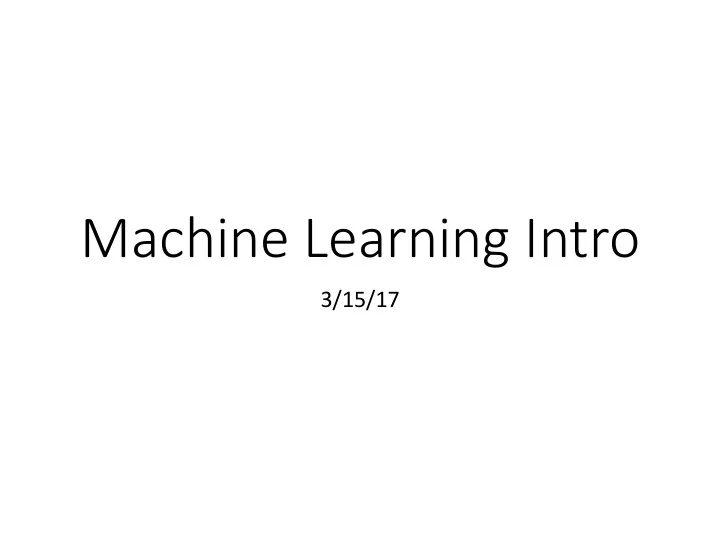

Machine Learning Intro 3/15/17
Recall: The Agent Function We can think of the entire agent, or some portion of it as implementing a function. • inputs: the agent’s internal state and what it perceives • outputs: the agent’s actions We have been thinking of this as a function in the programming sense. f (percept, state) = command Let’s now think of it instead as a function in the mathematical sense.
Agent Function Examples • state space search (example: traffic jam) • input = complete model of the state space • output = complete plan of action • game playing, online planning (example: hex) • input = current state • output = current action • Offline planning/learning (example: Pacman) • input = current state, history • output = current action
Machine Learning Approach Rather than program a function directly, generalize from data. • Gather example inputs & outputs. • Find a function that maps between inputs and outputs effectively. • Test how well that function generalizes to new examples.
Some examples we’ve already seen: Q-learning • Data consists of state/action/next state/reward. • Learn a mapping from state/action to value. Approximate Q-learning • Data consists of state/action/next state/reward. • Transform state/action into feature vector. • Learn a linear mapping from feature vector to reward.
Why learning? Can’t we just program the solution? • We can’t anticipate all of the possible situations an agent may face. • We want the agent to adapt to changes in the environment over time. • We may not know how to solve the problem. • We may want to model how humans learn.
What function should be learned? In q-learning, we learn the full agent function. • Q-learning updates generate a value function. • The value function implies an optimal policy. • Once learning is done, the agent function is trivial: for the current state, look up the best action. AlphaGo learned multiple helper functions: • An accurate move-probability distribution for use in the tree policy. • A fast-to-evaluate move-probability distribution for use in the default policy. • A board-evaluation heuristic.
Smaller units that we could learn. Instead of learning the whole agent function, we could learn… • State space representation • What features of the world are important for the task? • Utility function • What outcomes are better for the agent? • State evaluation heuristics • What direction seems more promising? • Other ideas?
What does the data set look like? • Discrete or continuous? • We mostly care about whether the output is continuous. • Do we know the right answer? • supervised • semi-supervised • unsupervised • Do we have all the data in advance? • online learning • How noisy is the data?
Supervised Learning: Regression • Input: x values, continuous y values • Output: simple function from x to y
Supervised Learning: Classification • Input: x values, discrete labels • Output: function to label new points
Unsupervised Learning: Clustering • Input: unlabeled x values • Output: breakdown into clusters
Unsupervised Learning: Dimensionality Reduction • Input: unlabeled x values • Output: lower-dimensional representation of the data
Semi-Supervised Learning: Reinforcement Learning • Input: states, occasional utilities • Output: values/policy
Online Learning Offline learning: we have all of the data in advance. Online learning: the data arrives incrementally, and we need to make decisions before we have it all. • Model must be easy to update with new data. • We may want to take actions just to gather better data. Similar (but not identical) to the online/offline planning distinction.
Evaluating Hypotheses • To measure the accuracy of a learned function, we use a test set of examples that are distinct from the training set . • A hypothesis generalizes well if it correctly predicts the output for the novel examples in the test set. • We prefer hypotheses that generalize well over ones that perform optimally on the training set.
Which function models the data better? There is often a tradeoff between complex hypotheses that fit the data better and simpler hypotheses that generalize better
Simple Learning Algorithm: Perceptrons Inspired by biological neurons. How a neuron works (extreme basics): • Connected to other neurons through dendrites. • Sense the activity of neighboring neurons. • If neighbors reach some threshold, activate. • On activation, send an electrical pulse down the axon.
Mathematical Model of a Neuron • Neuron represented by a node. • Connections to other neurons represented by edges. • Each edge has a weight. • Sum up weighted activation of neighbors. • Activate if sum is above threshold. ⇢ 0 if P j w j x j ≤ threshold output = 1 if P j w j x j > threshold
Boolean Functions with Neurons Perceptrons can represent many boolean functions. x1 x2 OR x1 x2 AND 0 0 0 0 0 0 0 1 1 0 1 0 1 0 1 1 0 0 1 1 1 1 1 1 Exercise: choose weights and threshold = 0.5 1 threshold to represent AND x1 x2 1
Recommend
More recommend